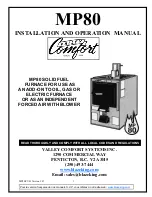
17
INSTALLATION EXAMPLE
Elevation:
................................................5,000 feet
Type of Gas:
.........................................Natural Gas
Local Heating Value of Gas:
............................750
From Table 9, fi nd 750 and follow down the column,
stop at the 5,000 feet row. The heating value listed is
LOW. Table 11 will be used to determine orifi ce size and
manifold pressure.
with a heating value of more than 1,000 Btu per cubic foot
and Table 11 (Low) is for less than 1,000 Btu per cubic
foot.
To determine which table to use:
1. Consult the local utility for the local heating value at
your installation site.
2. From Table 9 (page 33), fi nd your local heating value
as supplied by the utility company. Follow down the
column and stop at your altitude level.
3. If your sea level heating value is HIGH, use Table 10
or if it’s LOW, use Table 11 (page 34).
After changing the regulator pressure or the orifi ces, it is
required that you measure the gas input rate. This may be
accomplished in the usual way, by clocking the gas meter
and using the local gas heating value. See Verifying and
Adjusting the Input Rate section (page 20).
IMPORTANT NOTE: Observe the action of the burners
to make sure there is no yellowing, lifting or fl ashback
of the fl ame.
Conversion to LP/Propane
WARNING:
The furnace was shipped from the factory
equipped to operate on natural gas. Conversion
to LP/propane gas must be performed by
qualifi ed service personnel using a factory
supplied conversion kit. Failure to use the
proper conversion kit can cause fi re, explosion,
property damage, carbon monoxide poisoning,
personal injury, or death.
IMPORTANT NOTE: When converting a low NOx furnace
from Natural gas to LP/propane gas, it is necessary
to remove the NOx Baffl es from the furnace.
Conversion to LP/propane is detailed in the installation
instructions provided with the conversion kit. Generally,
this will require the replacement of the burner orifi ces and
the spring found under the cap screw on the pressure
regulator. In the U.S. if installation is above 2,000 ft., refer
to Table 8 (page 33) to determine the correct orifi ce size
and manifold pressure. When conversion is complete, verify
the manifold pressure and input rate are correct as listed
in the Tables. Approved conversion kits are listed below:
• The United States LP/Propane Gas Sea Level and High
Altitude Conversion Kit (P/N 904914) is for LP/propane
conversion in the United States at altitudes between
zero and 10,000 ft. above sea level.
Please
follow the
instructions provided with the kit
.
• The Canadian LP/Propane Gas Sea Level and High
Altitude Conversion Kit (P/N 904915) is for LP/propane
conversions in Canada at altitudes between zero and
4,500 ft. above sea level.
Please
follow the instructions
provided with the kit
.
ELECTRICAL WIRING
WARNING:
To avoid electric shock, personal injury, or death,
turn off the electric power at the disconnect
or the main service panel before making any
electrical connections.
• Electrical connections must be in compliance with all
applicable local codes and the current revision of the
National Electric Code (ANSI/NFPA 70).
• For Canadian installations the electrical connections
and grounding shall comply with the current Canadian
Electrical Code (CSA C22.1 and/or local codes).
CAUTION:
Label all wires prior to disconnection when
servicing controls. Wiring errors can cause
improper and dangerous operation. Verify
proper operation after servicing.
IMPORTANT NOTE: If replacing any of the original
wires supplied with the furnace, the replacement wire
must be copper wiring and have a temperature rating
of at least 105° F (40° C). For electrical specifi cations,
refer to the furnace nameplate or Table 2 (page 18).
Line Voltage Wiring
It is recommended that the line voltage (115 VAC) to
the furnace be supplied from a dedicated branch circuit
containing the correct fuse or circuit breaker for the
furnace (Table 2).
IMPORTANT NOTES:
An electrical disconnect must be installed readily
accessible from and located within sight of the furnace.
See Figure 13 (page 18) or the wiring diagram label
inside of the control door. Any other wiring methods
must be acceptable to authority having jurisdiction.
















































